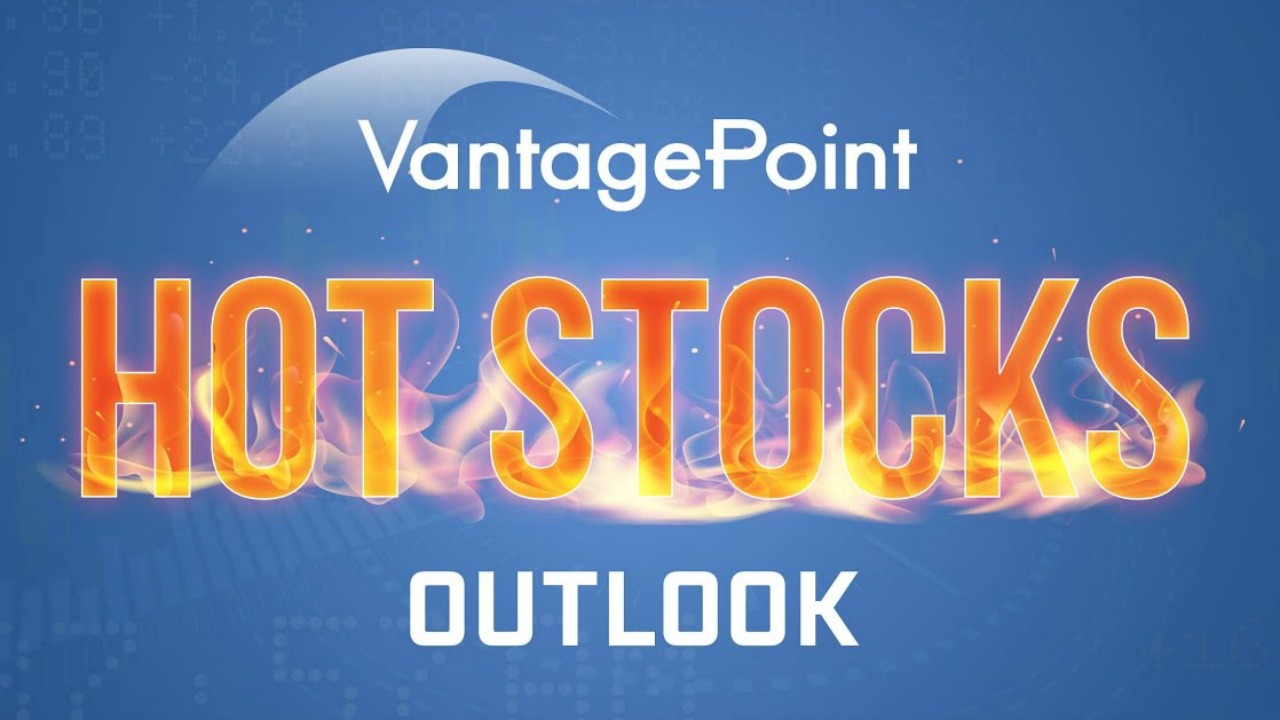| This Week’s a.i. Stock Spotlight is TESLA Motors ($TSLA) |

Tesla Inc. ($TSLA), a titan in the automotive and energy sectors, stands out for its revolutionary approach and bold vision. Founded in 2003 in Austin, Texas by a group including Eberhard and Tarpenning, with Elon Musk quickly becoming a pivotal figure, Tesla has disrupted traditional industries with its focus on electric vehicles (EVs) and sustainable energy solutions. Its financial trajectory over the past five years showcases robust revenue growth and a significant improvement in net income, underpinned by expanding global sales and production efficiencies. Despite not offering dividends, Tesla’s aggressive reinvestment strategy has fueled its expansion and dominance, particularly in the EV market where it competes with giants like GM and Ford, as well as newer players like NIO.
Tesla’s market strategy is fortified by constant innovation, especially in battery technology and autonomous driving systems, positioning it well against traditional automakers and emerging EV companies.
Recent strategic moves include continuous upgrades to vehicle models and expansions in the energy sector, highlighted by the acquisition of SolarCity in 2016. Looking forward, Tesla’s prospects remain high with burgeoning global demand for EVs, though it navigates complex supply chain and regulatory environments.
Tesla’s story is also one of cultural impact and technological firsts, from launching the first fully electric sports car, the Roadster, to reaching significant sales milestones like 1 million EVs sold by March 2020. Its Gigafactories are pivotal in reducing battery costs, further testifying to Tesla’s role as a leader in pushing the boundaries of technology and sustainability in the automotive world.
Tesla, under the visionary leadership of Elon Musk—who also serves as a key advisor to President Trump — has unveiled ambitious plans for a fully autonomous robo-taxi, aptly named the Cybercab. With a regulatory landscape evolving to be more favorable to self-driving technology, Musk’s timeline of a 2026 rollout for the Cybercab could very well be within reach, provided the technical hurdles are navigated successfully. The Trump administration is reportedly pushing for a robust federal framework that would pave the way for fully autonomous vehicles — those devoid of traditional driving controls like steering wheels and pedals. This groundbreaking development could accelerate the debut of such vehicles, potentially rewriting the rules of road travel.
However, this shift spells a potential challenge for ride-sharing giants UBER and Lyft. While Tesla’s stock basks in the glow of favorable news, Uber and Lyft have found themselves on the back foot. Shares of Uber and Lyft have fallen roughly by 10% since the election, signaling investor concerns that an autonomous future could disrupt traditional ride-sharing models. This scenario underscores a pivotal moment in transportation — a shift that could redefine winners and losers in this high-stakes race to autonomy.
Tesla’s potential release of a fully autonomous Cybercab could catalyze a monumental shift across several industries, particularly the insurance sector. Many vehicle owners might forego the burdens of ownership, like high maintenance and insurance costs, in favor of using a Cybercab. This change could ripple through the insurance industry as traditional policies become less necessary. Moreover, the Cybercab offers an intriguing investment prospect — not just for individuals but also for companies and pension funds. By owning fleets of these autonomous vehicles, investors could tap into a new stream of income, fundamentally altering investment strategies within the transportation domain. Such a shift would also pose significant challenges to established ride-sharing models, threatening companies like Uber and Lyft with a more efficient, potentially cheaper alternative.
Believers in this Tesla-centric reality maintain that it will propel the stock much higher. Cynics believe that this type of technology is still in the distant future and the regulatory hurdles are still very high.
Since President Trump’s victory in the 2024 election, Tesla’s stock has soared by an impressive 28%. President Trump has shown his confidence in Elon Musk by appointing him to lead a new Department of Government Efficiency, aimed at cutting wasteful spending and slicing through burdensome regulations. This strategic move could further accelerate Tesla’s innovative projects, including the autonomous Cybercab, propelling the company to new heights and redefining urban mobility as we know it.
Here are Tesla’s Revenue and Earnings metrics over the past several years. Even critics are forced to admit that these numbers are super impressive.
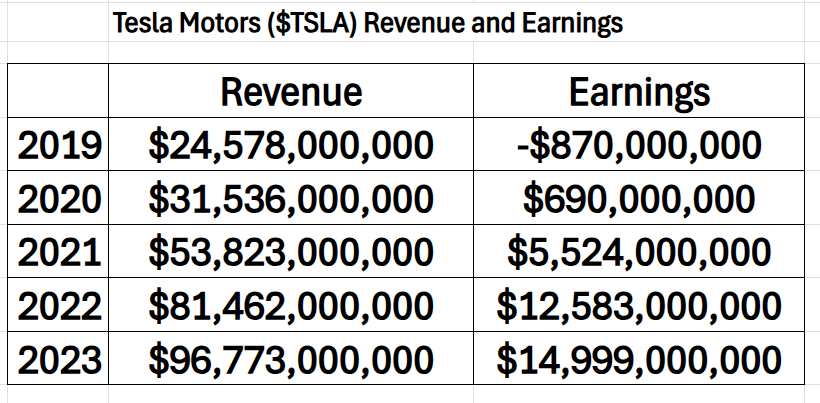
In the last 4 years revenue has increased 204% while earnings have grown 2074%.
Elon Musk has long championed artificial intelligence (A.I.) and autonomous driving technology as the cornerstone of Tesla’s future expansion. With robust government support, investors are closely watching, hopeful that Musk’s strategic focus will culminate in substantial gains, solidifying Tesla’s leadership in innovative automotive technologies.
This melding of futuristic vision and regulatory backing could very well be the recipe for a spectacular success story in the tech-driven auto industry.
In this stock study, we will look at an analysis of the following indicators and metrics which are our guidelines, and which dictate our behavior in deciding whether to buy, sell or stand aside on a particular stock.
- Wall Street Analysts Ratings and Forecasts
- 52 Week High and Low Boundaries
- Best-Case/Worst-Case Analysis
- Vantagepoint A.I. Triple Cross Indicator
- Neural Network Forecast (Machine Learning)
- VantagePoint A.I. Daily Range Forecast
- Intermarket Analysis
- Our Suggestion
While we make all our decisions based upon the artificial intelligence forecasts, we do look at the fundamentals briefly, just to understand the financial landscape that $TSLA is operating in.
Wall Street Analysts Forecasts

Over the past three months, 29 Wall Street analysts have been scrutinizing Tesla Motors, with their 12-month price targets ranging significantly. The average target sits at $233.82, soaring to a high of $400 and plunging to a low of just $24.86. This stark disparity — over $375 or 108% of the current price — underscores the expected volatility and highlights why Tesla is seen as such a turbulent stock. For those looking to invest in Tesla, it’s crucial to be prepared for substantial fluctuations. This spread in valuations isn’t just noise; it’s indicative of deeply divergent views on Tesla’s financial health and market trajectory, a scenario that seasoned traders might describe as having “volatility baked in.”
52 Week High and Low Boundaries

Savvy traders always keep their eyes on the 52-week high and low of stocks to gauge their annual performance. These thresholds are not just numbers; they are essential indicators of a stock’s strength and weakness over the year. Tesla demonstrated a striking range from a low of $138.80 to a high of $358.64 this past year. That’s a substantial variance of $219.84, amounting to 64% of its recent closing price. This wide range offers traders a clear view of the stock’s historical volatility and helps them strategize accordingly.
The first thing we can notice as traders is that this historical volatility of 64% often limits uninterrupted rallies and declines to values which tightly mimic these seismic moves.
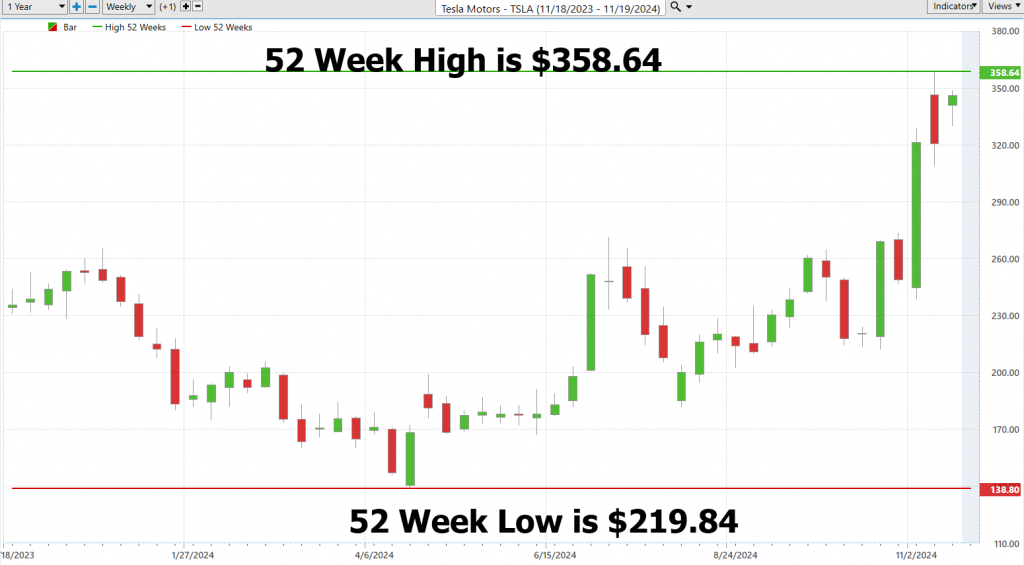
To truly appreciate the impressive journey of Tesla ($TSLA), we need to zoom out and consider its performance over the last decade. This long-term view reveals a staggering peak price of $414.40 and a low of just $9.40. As traders, our focus is homed in on performance metrics like these — everything else is secondary. Tesla continues to captivate our attention not only due to its remarkable market achievements but also because of the compelling narrative and significant developments surrounding the company. Tesla ($TSLA) is scaling remarkably well and while massive challenges remain it is hard to bet against Elon Musk based upon the successes he has had.
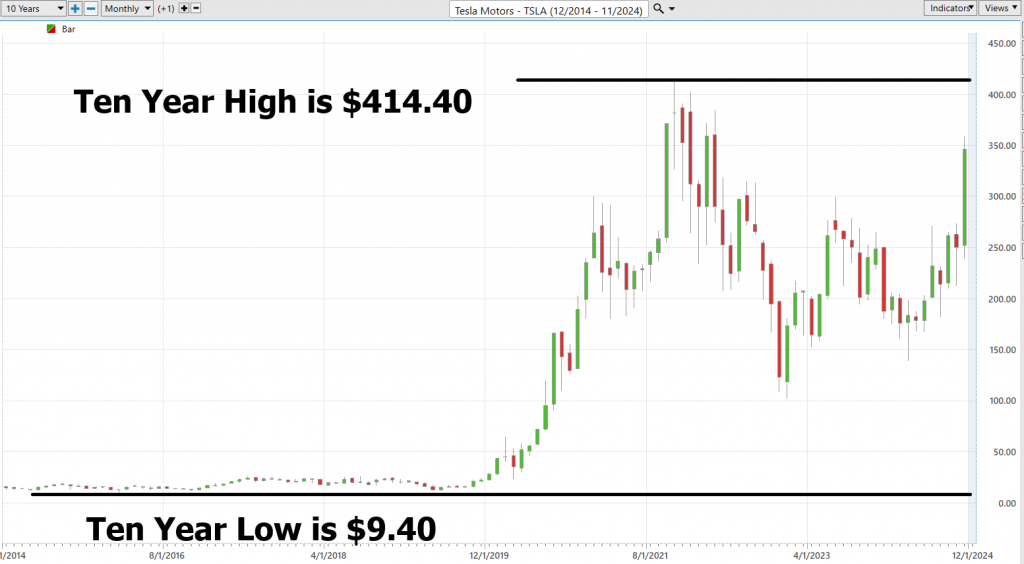
Best-Case/Worst-Case Analysis
In the stock market, volatility can be a perplexing and often harsh reality for traders, particularly when they find themselves on the losing end. To get a real handle on what volatility means in action, we analyze and compare the magnitude of the stocks uninterrupted rallies and declines over the past year. Analyzing the stock’s most significant uninterrupted rallies and declines over the past year can reveal much about its behavior under extreme conditions. This isn’t just about observing numbers; it’s about understanding the broader implications of these movements for crafting strategies that acknowledge the stock’s potential for large price swings. Such an analysis helps traders not only prepare for future volatility but also develop a trading framework that respects the full spectrum of market emotions, from bullish optimism to bearish pessimism, thereby equipping them with the insights to potentially profit from market volatility while being mindful of the risks.
First, we look at the best-case scenario by measuring the largest uninterrupted rallies over the past 52 weeks.
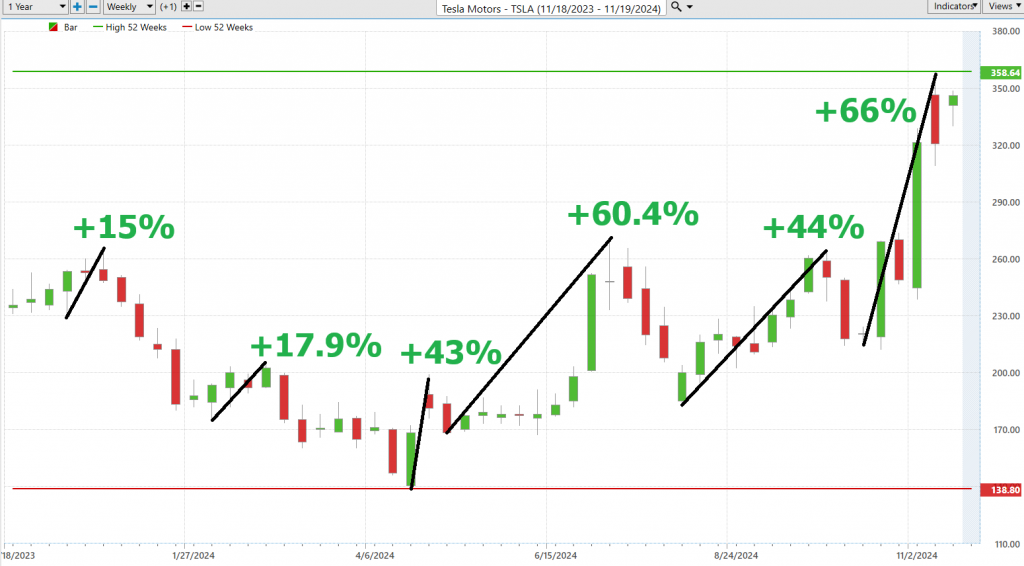
Next, we do the inverse and measure the largest uninterrupted declines over the past year.
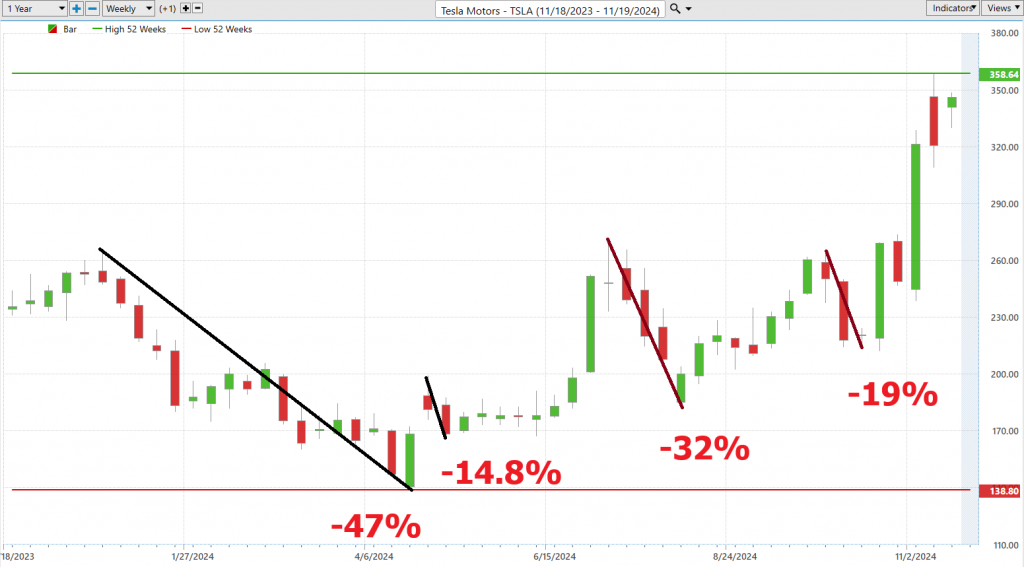
The charts for Tesla ($TSLA) clearly highlight the bullish trend dominating its market presence, but they also bring to light the stock’s inherent volatility, with possible downturns reaching as much as 47% and spikes as high as 66% in mere weeks. This visual analysis is pivotal for traders, offering a balanced view of the risks and rewards involved with Tesla’s stock. Moreover, comparing Tesla’s performance against broader market indices sharpens our understanding of its relative strength or weakness, allowing traders to align their strategies with both Tesla’s specific movements and broader market dynamics. This comparative approach is essential for traders looking to navigate through Tesla’s price fluctuations and global market shifts with informed precision.
When we compare the $TSLA to the broader market we see that it has outperformed across all of the time frames.

To get more granular we often like to see how a company performed against the top competitors in its niche. Below is a performance analysis of $TSLA against 5 of its major competitors.

The 5-year beta of Tesla ($TSLA) is approximately 2.30. So, it is 130% more volatile than the broader market indexes.
Imagine you’re playing a video game where your goal is to follow a moving line as closely as possible. This moving line represents the overall stock market. If you follow it perfectly, you move exactly as the line does; this is like having a beta of 1.0, where your movements (or stock price changes) perfectly match the market’s ups and downs.
Now, Tesla has a beta of about 2.30. This means if the market goes up by 1%, Tesla’s stock is likely to go up by about 2.30%. Conversely, if the market goes down by 1%, Tesla’s stock might go down by about 2.30%. This higher beta indicates that Tesla’s stock is more volatile, or swings more dramatically compared to the overall market. So, in our video game analogy, if Tesla is your character, it’s moving much faster and more wildly than the line you’re trying to follow. This can make Tesla a riskier choice, but also potentially more rewarding if you’re good at anticipating when those big moves happen.
Vantagepoint A.I. Predictive Triple Cross Indicator
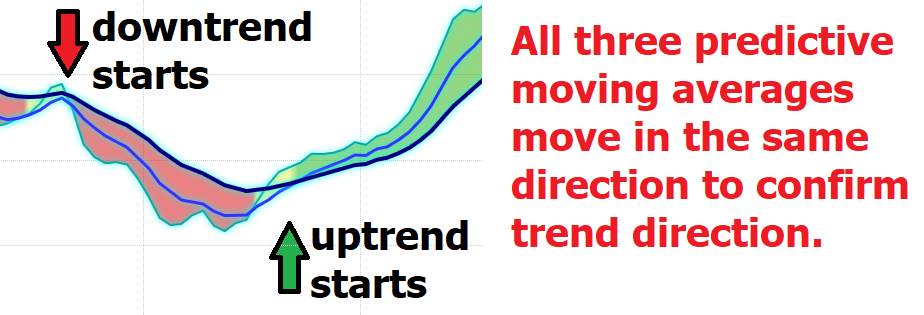
A basic moving average (MA) strategy is a fundamental tool in the trader’s arsenal, primarily used to gauge the market’s direction by employing two key moving averages: a short-term MA and a long-term MA. The essence of a moving average strategy lies in its execution—buying when the short-term MA crosses above the long-term MA, suggesting an upward trend, and selling when the short-term crosses below, indicating a downturn. This approach offers simplicity and clarity in trend identification, making it an attractive option for traders at all levels, particularly due to its potential for automation, which minimizes emotional trading errors.
However, the moving average strategy is not without its drawbacks. It inherently lags because it is based on past prices, which can delay trade entries and exits, potentially reducing profits or increasing losses. The strategy also struggles in volatile or sideways markets, often generating numerous false signals or whipsaws that can lead to repeated minor losses. Additionally, since it does not account for changes in market volatility or trading volume, it may overlook important cues that indicate the strength or weakness behind price movements.
Enhancing this basic strategy is the goal and objective of the Triple Cross Indicator from Vantagepoint A.I. Consider this: It harnesses not one, not two, but three predictive moving averages—short (3-day), medium (8-day), and long (18-day). The genius of it? It provides those critical early alerts on potential trend reversals, essentially giving traders a nearly prophetic glimpse into what the market could do next. That’s not just smart; it’s like having a trading ninja in your corner guiding your every move in the stock market.
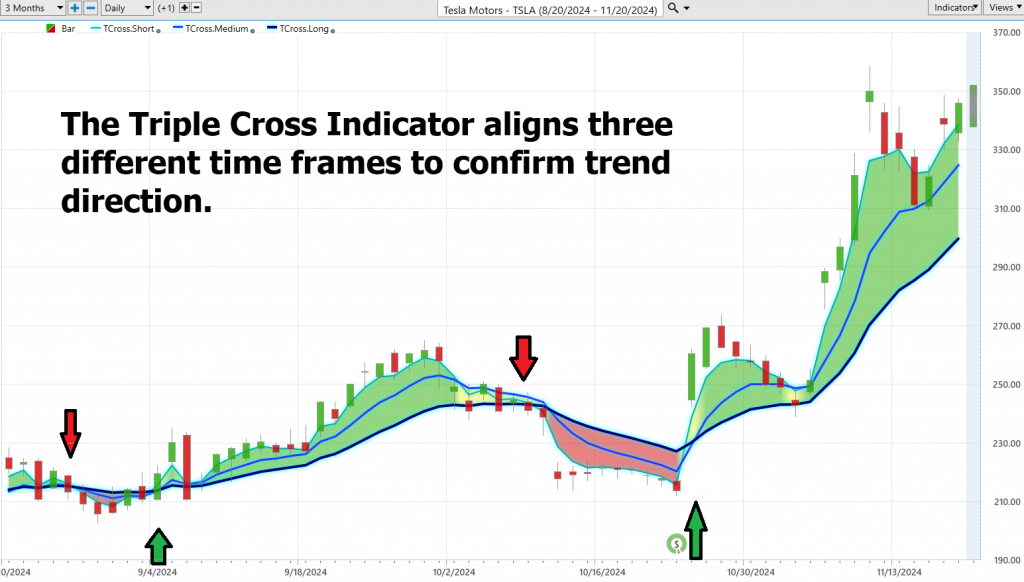
This sophisticated strategy employs three predictive moving averages over short, intermediate, and long intervals to signal impending trend reversals, providing traders with an almost prescient insight into forthcoming market movements. The Triple Cross strategy is distinguished by its precision and restraint, waiting for alignment across all three timeframes to confirm a trend change, thereby filtering out market noise and offering clear, reliable signals. This not only boosts trader confidence but also protects against premature and risky decisions, making it an essential component in navigating the turbulent waters of stock trading.
The Triple Cross strategy distinguishes itself through its precision and measured approach. By waiting for alignment across three different timeframes before signaling trend changes, it avoids premature reactions and filters out irrelevant market fluctuations. This method provides clear, dependable signals and reinforces trading decisions with data confirmed from three sources, thus improving the quality and accuracy of trades. More than just a trading tool, the Triple Cross acts as a protective guide, boosting trader confidence and safeguarding against impulsive, risky decisions. It is an indispensable ally in the often-volatile stock trading environment.
Neural Network Forecast (Machine Learning)
Neural networks in trading reflect an advanced utilization of artificial intelligence, analogous to the way the human brain processes and learns from information. These systems analyze extensive datasets from market activities to project future price movements. The structure of these networks involves multiple layers of ‘neurons,’ where each layer meticulously processes a portion of the data, continually refining its connections based on accumulated learning to enhance predictive accuracy incrementally.
Traders construct these neural networks by engaging them in extensive training with large datasets, which encompass historical price movements and a variety of market indicators. This ongoing process of analysis and adjustment fine-tunes the neural network’s ability to sharpen its forecasting capabilities by optimizing its internal structure for pattern recognition in market data. In practical terms, instruments like the Neural Index Indicator serve crucial roles, akin to a traffic signal, by signaling the robustness or frailty of market conditions. When used alongside analytical tools such as the Triple Cross Indicator, these neural networks empower traders to pinpoint optimal trading opportunities with greater precision.
The Neural Index appears at the base of the VantagePoint Charts and clearly delineates the expectation for the next 48 to 72 hours.
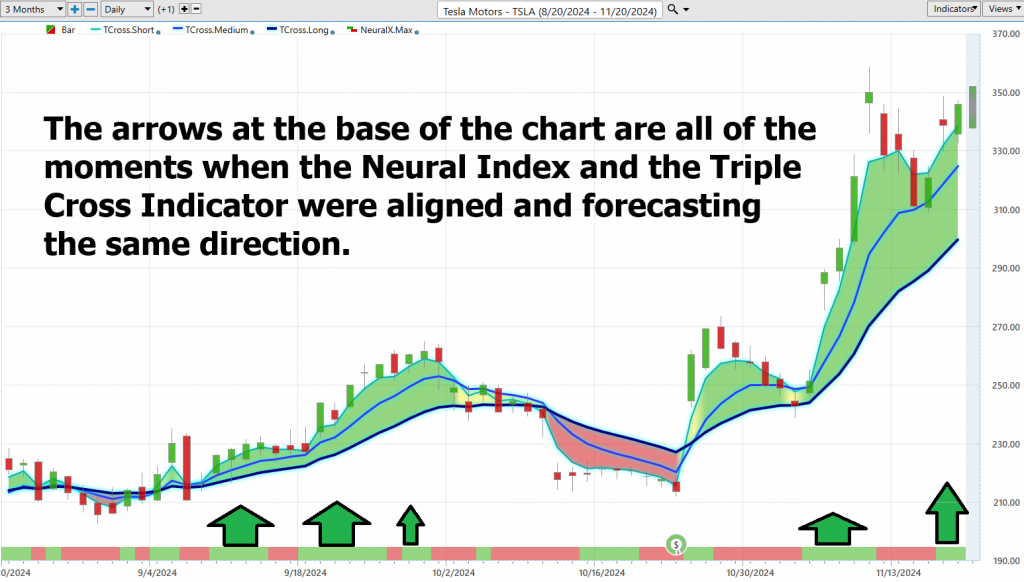
This integration of sophisticated analysis tools not only refines trading accuracy but also aids traders in making well-informed, strategic decisions in dynamic market environments. Such technologies represent a significant stride in blending empirical data analysis with intuitive market understanding, a paradigm highly valued in strategic trading frameworks.
VantagePoint A.I. Daily Range Forecast
In the high-stakes world of trading, timing is not merely a convenience — it is the core of success. For those at the apex of this field, the VantagePoint A.I. Daily Range Forecast isn’t just another tool — it’s akin to a seasoned mentor. Designed with unmatched precision, it highlights those crucial moments to either seize an opportunity or step back, with each decision having the potential to dramatically sway your trading results.
Yet, in a market teeming with volatility, simply having access to data is not enough. The true mastery lies in converting this raw data into actionable insights, achieved through cutting-edge technologies like artificial intelligence, machine learning, and neural networks. These aren’t mere buzzwords; they are essential tools that sharpen your trading edge, slicing through the cacophony of market noise to deliver crisp, accurate forecasts.
To illustrate, let’s examine the daily, weekly, and monthly average trading ranges for $TSLA, showcasing the intricacies of market behavior over the past year.

Navigating the trading landscape demands pinpointing the optimal times to enter or exit a trade—timing is everything. Are you curious about identifying the best moments to engage or disengage in your trading endeavors? View the Daily Range Forecast as your personal navigator in the bustling world of trade. This tool lays out a precise route for short-term trading, equipping you to tread through market volatilities with assuredness and strategic foresight. There’s no room for speculation here; the forecast provides you with the precise trading range for the upcoming day, complete with trend indications. Observe the chart below and note how distinctly each day’s trend is outlined, offering you a crystal-clear expectation and forecast for your trading activities.
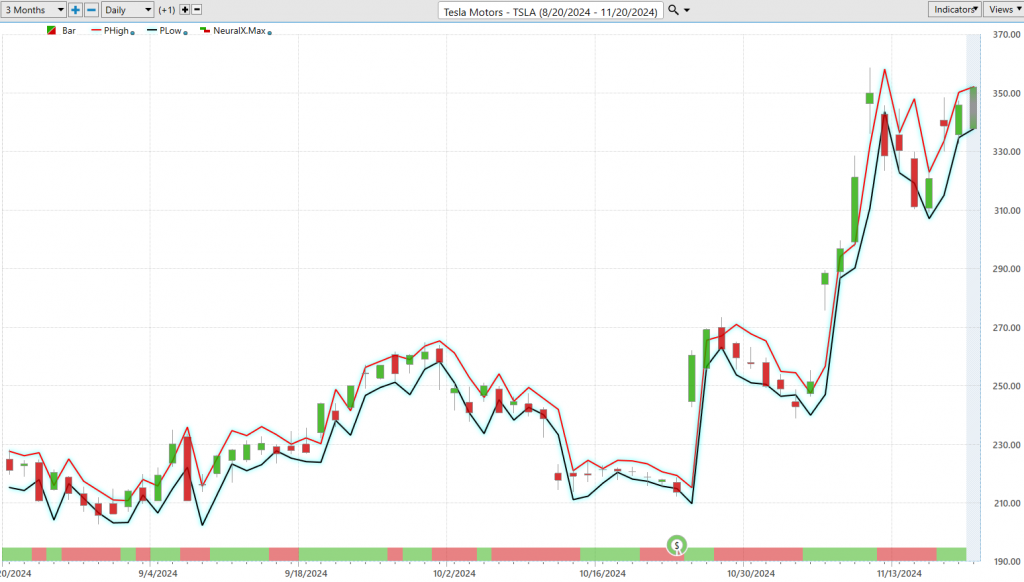
Intermarket Analysis
Intermarket analysis is a critical approach for traders looking to understand the complexities of the global markets and how various segments are interconnected. This method examines the relationships between different sectors such as stocks, bonds, currencies, and commodities to anticpate potential market movements. For a company like Tesla, which sits at the crossroads of technology, consumer discretionary, and clean energy, understanding these interconnections is vital. For instance, ETFs that hold Tesla shares, like ARKQ and ARKW, directly affect its stock through trading activities. Additionally, broader market indicators like the NASDAQ or S&P 500 reflect investor sentiment towards technology and consumer sectors, influencing Tesla’s performance.
Furthermore, Tesla’s alignment with clean energy makes it susceptible to shifts in this sector. ETFs like ICLN and QCLN, which focus on clean energy, can indicate how investor sentiment towards renewable resources might impact Tesla’s valuation. Meanwhile, global economic factors, such as currency fluctuations and commodity prices, also play a role. For example, rising crude oil prices might increase the attractiveness of electric vehicles, potentially boosting Tesla’s sales. Conversely, a strong U.S. dollar could dampen its earnings abroad. These insights gained from intermarket analysis are not just academic; they provide a strategic edge to traders by revealing underlying trends and potential signals across different markets.
Thus, intermarket analysis is not merely about tracking individual stocks or sectors but understanding a tapestry of global interactions that influence market dynamics. This approach equips traders with a more holistic view of the markets, enabling them to make more informed decisions by anticipating how changes in one market can ripple through others. It’s an indispensable tool in the trader’s arsenal, enhancing their ability to navigate the complexities of the market and strategically position their investments in a globally interconnected landscape.
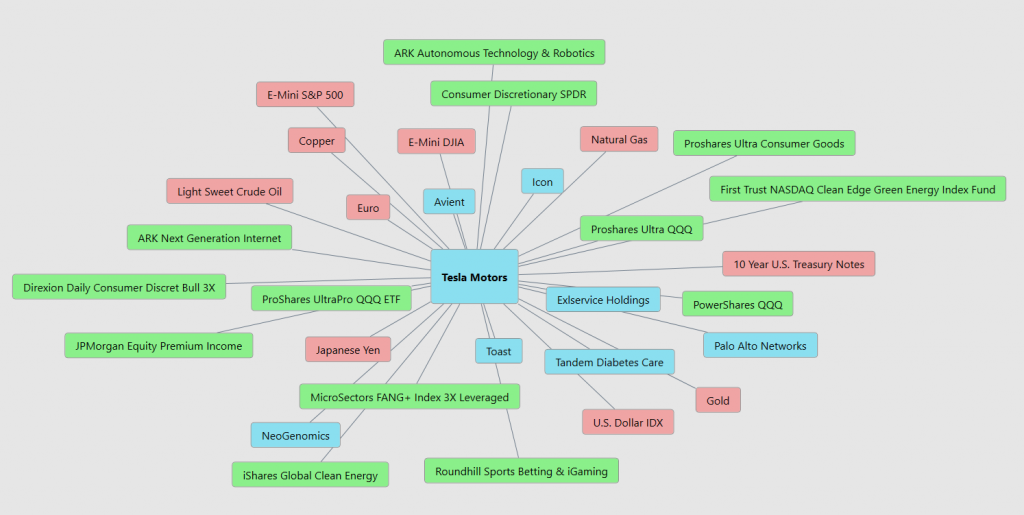
VantagePoint’s A.I. Intermarket analysis graphic is worthy of every traders consideration because today everything is interconnected. Studying the changes in this graphic regularly also assists traders in finding hidden gems that show great promise moving forward.
Our Suggestion
Looking ahead, Tesla faces both significant opportunities and risks. The company’s expansion into new markets and continuous innovation in electric vehicles and A.I. presents substantial growth potential. However, challenges such as possible trade barriers, the competitive pressure from Chinese manufacturers, and maintaining profitability amidst aggressive expansion efforts pose risks to its ambitious trajectory. The balance of these factors will be crucial for Tesla’s sustained success and market leadership.
Tesla’s next earnings call is January 29, 2024. Increases and revenue will bolden the outlook and serve as catalysts for much higher prices.
Investors and market watchers are keenly awaiting the next earnings call, expected to review the fourth quarter of 2024. This upcoming discussion is anticipated to provide crucial insights into Tesla’s year-end performance and strategic directions for the following year. It will be a pivotal moment to gauge how Tesla plans to navigate the complexities of an increasingly competitive and dynamic global market, and what steps it is taking to solidify its position at the forefront of the automotive and technology sectors.
You absolutely need to keep an eye on Tesla ($TSLA) as it’s turning out to be a critical gauge for the broader market’s trend direction. Looking ahead, there are a plethora of fantastic trading opportunities brewing with Tesla over the next year. And let’s not skip over the potential game-changer here — if Tesla rolls out its Robotaxi, we’re talking about an exponential growth curve. This isn’t just about cars; it’s about revolutionizing multiple sectors of the economy. Tesla is poised to shake things up on a grand scale.
Practice great money management on all your trades.
Learn to trade with a.i.
It’s not magic.
It’s machine learning.
Disclaimer: THERE IS A HIGH DEGREE OF RISK INVOLVED IN TRADING. IT IS NOT PRUDENT OR ADVISABLE TO MAKE TRADING DECISIONS THAT ARE BEYOND YOUR FINANCIAL MEANS OR INVOLVE TRADING CAPITAL THAT YOU ARE NOT WILLING AND CAPABLE OF LOSING.
VANTAGEPOINT’S MARKETING CAMPAIGNS, OF ANY KIND, DO NOT CONSTITUTE TRADING ADVICE OR AN ENDORSEMENT OR RECOMMENDATION BY VANTAGEPOINT AI OR ANY ASSOCIATED AFFILIATES OF ANY TRADING METHODS, PROGRAMS, SYSTEMS OR ROUTINES. VANTAGEPOINT’S PERSONNEL ARE NOT LICENSED BROKERS OR ADVISORS AND DO NOT OFFER TRADING ADVICE.









